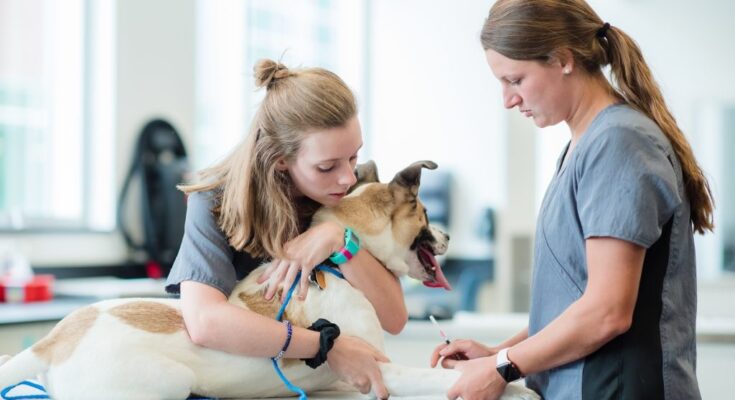The veterinary technology program is your gateway to a fulfilling and impactful career in animal healthcare.
From day one, you’ll dive into a hands-on learning experience that prepares you to tackle real-world challenges with confidence and skill.
Whether it’s mastering the intricacies of animal anatomy or developing the soft skills needed to communicate effectively with pet owners, this program is designed to equip you with everything you need to succeed.
The Journey Begins: What to Expect from a Veterinary Technology Program
Embarking on a veterinary technology program is more than just hitting the books—it’s about becoming immersed in a world where your passion for animals meets cutting-edge medical knowledge.
In your first semester, you’ll likely find yourself in labs, learning to handle a variety of animals with care and precision.
One of the first things you’ll notice is how hands-on the program is.
You’re not just reading about animal care; you’re doing it.
In a typical week, you might be in a lab on Monday, learning how to draw blood from a cat.
By Wednesday, you could be practicing your diagnostic skills on a dog.
Friday might find you in a classroom, delving into the complexities of veterinary pharmacology.
Each day builds on the last, ensuring that by the time you graduate, you’re not just knowledgeable but also confident in your ability to apply what you’ve learned.
Real-Life Experience: From the Classroom to the Clinic
One of the most exciting aspects of the veterinary technology program is the opportunity to gain real-life experience in a clinical setting.
Most programs include internships or externships, where you’ll work alongside seasoned veterinary professionals.
This isn’t just busywork—these experiences are where the classroom lessons truly come to life.
Imagine this: You’re in a clinic, and a dog comes in with a mysterious illness.
The veterinarian on duty turns to you and asks for your opinion.
Thanks to your training, you’re able to suggest a possible diagnosis, which the vet confirms after further tests.
It’s moments like these that highlight the importance of the program’s practical components.
Skills That Set You Apart: What You’ll Learn in a Veterinary Technology Program
A veterinary technology program covers a wide range of topics, ensuring that you’re well-rounded and prepared for anything.
You’ll delve into animal anatomy, learning how to identify and treat various conditions.
Pharmacology will teach you about the medications used in animal care, while courses in diagnostic imaging will show you how to use X-rays and ultrasounds to uncover hidden issues.
But it’s not all about hard skills.
Soft skills are equally important.
Veterinary technicians often serve as the bridge between veterinarians and pet owners.
That means you’ll need to develop strong communication skills, empathy, and the ability to explain complex medical information in a way that’s easy to understand.
These are the skills that will set you apart in the field and make you an invaluable asset to any veterinary team.
Preparing for the Future: The Benefits of a Veterinary Technology Program
Graduating from a veterinary technology program opens up a world of opportunities.
You’re not just limited to working in a veterinary clinic.
With the skills and knowledge you’ve gained, you could find yourself working in a research lab, assisting with groundbreaking studies on animal health.
Or, you might work in a zoo, caring for exotic animals and helping to conserve endangered species.
The program also prepares you for certification exams, which are often required to work as a veterinary technician.
These exams can be challenging, but the comprehensive education you receive will ensure that you’re more than ready to tackle them.
One of the most significant benefits of completing this program is the sense of fulfillment it brings.
You’re not just working a job—you’re making a difference in the lives of animals and the people who love them.
Every day, you have the opportunity to alleviate pain, improve health, and provide comfort.
That’s a reward that goes far beyond any paycheck.
First-Hand Insights: A Day in the Life of a Veterinary Technician
To give you a real sense of what it’s like to work as a veterinary technician, let’s look at a typical day.
After graduating from a veterinary technology program, many techs find themselves in a fast-paced environment where no two days are the same.
Your day might start with preparing the clinic for the first patients.
This could involve setting up examination rooms, checking equipment, and reviewing the day’s schedule.
Soon, the first patient arrives—a nervous cat with a persistent cough.
You assist the veterinarian in examining the cat, drawing on the skills you learned during your program.
Later, an emergency case comes in—a dog hit by a car.
This is where your training truly shines.
You assist with X-rays, monitor the dog’s vital signs, and provide the support the veterinarian needs to perform life-saving surgery.
By the end of the day, you’ve helped treat multiple animals, comforted worried pet owners, and ensured that the clinic runs smoothly.
It’s a demanding job, but the rewards are immeasurable.
The Road Ahead: Continuing Your Education and Advancing Your Career
The veterinary technology program is just the beginning.
Once you’ve graduated and gained some experience, you might decide to specialize.
Veterinary technicians can focus on areas like anesthesia, dentistry, or emergency care.
These specializations often require additional education and certification, but they open up even more career opportunities.
For those who love learning, the veterinary field offers endless possibilities.
You might choose to pursue further education, such as a degree in veterinary medicine.
Or, you could attend conferences, workshops, and seminars to stay up-to-date with the latest advancements in animal healthcare.
No matter what path you choose, the foundation you build in your veterinary technology program will serve you well.
You’ll have the knowledge, skills, and confidence to pursue your passion and make a lasting impact in the veterinary field.
Conclusion: Your Future in Veterinary Technology
Choosing to enroll in a veterinary technology program is more than just a step towards a career—it’s a commitment to improving the lives of animals and the people who care for them.
With the comprehensive education you receive, coupled with real-world experience, you’ll be well-prepared to enter the veterinary field with confidence.
The journey is challenging but incredibly rewarding.
And as you move forward in your career, you’ll find that the skills and knowledge you gain in your program will continue to support you, whether you’re in a clinic, a research lab, or even a zoo.
Take the first step today and explore the possibilities that a veterinary technology program can offer.
It might just be the start of an exciting and fulfilling career.
Bio
Cynthia Chapink has a strong background in educational research and a passion for lifelong learning. She has become a respected figure in the academic community at Platt College.




